stop start TOYOTA YARIS HATCHBACK 2021 Service Manual
[x] Cancel search | Manufacturer: TOYOTA, Model Year: 2021, Model line: YARIS HATCHBACK, Model: TOYOTA YARIS HATCHBACK 2021Pages: 568, PDF Size: 110.34 MB
Page 234 of 568
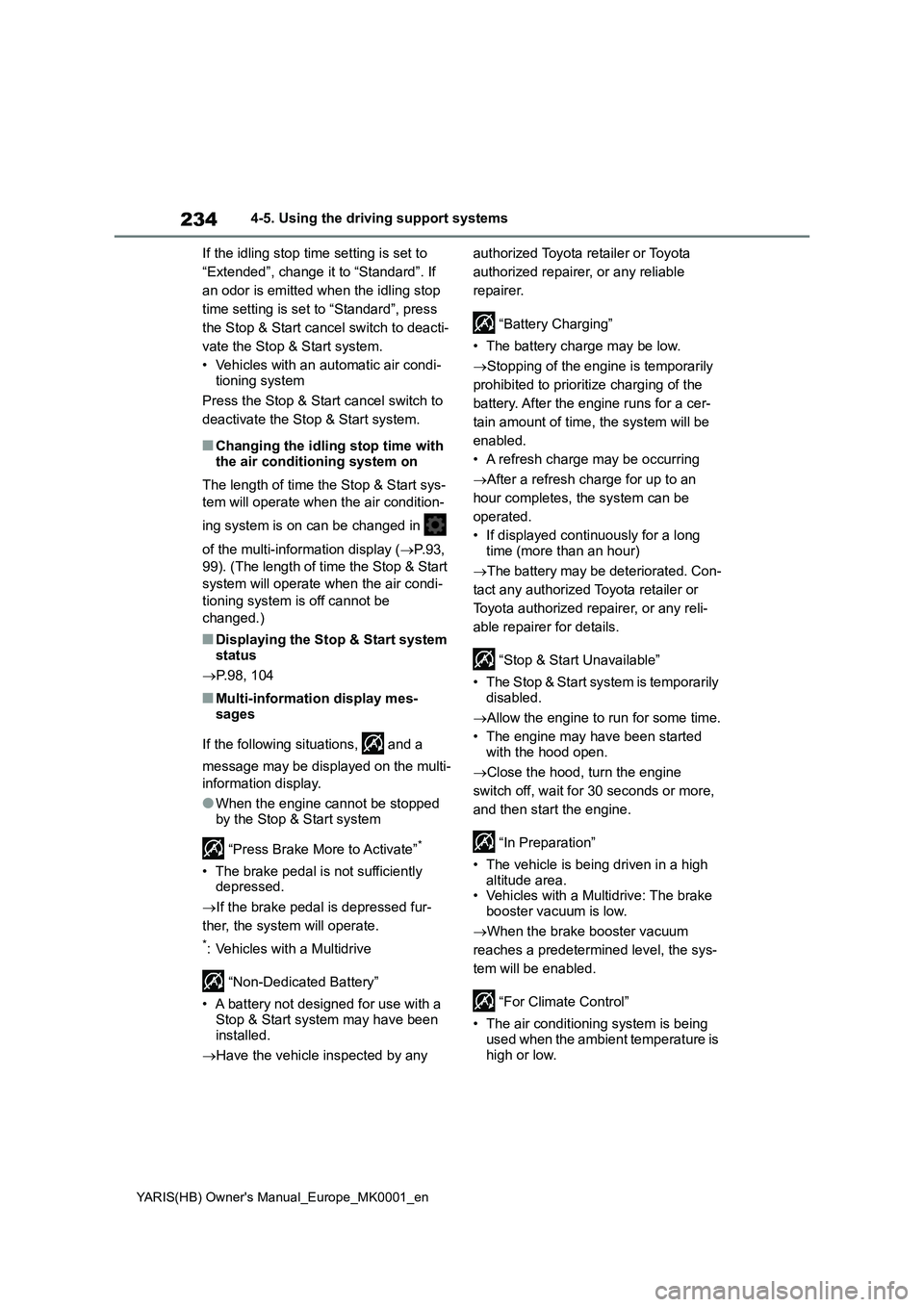
234
YARIS(HB) Owner's Manual_Europe_MK0001_en
4-5. Using the driving support systems
If the idling stop time setting is set to
“Extended”, change it to “Standard”. If
an odor is emitted when the idling stop
time setting is set to “Standard”, press
the Stop & Start cancel switch to deacti-
vate the Stop & Start system.
• Vehicles with an automatic air condi-
tioning system
Press the Stop & Start cancel switch to
deactivate the Stop & Start system.
■Changing the idling stop time with
the air conditioning system on
The length of time the Stop & Start sys-
tem will operate when the air condition-
ing system is on can be changed in
of the multi-information display (→P.93,
99). (The length of time the Stop & Start
system will operate when the air condi-
tioning system is off cannot be
changed.)
■Displaying the Stop & Start system
status
→P.98, 104
■Multi-information display mes-
sages
If the following situations, and a
message may be displayed on the multi-
information display.
●When the engine cannot be stopped
by the Stop & Start system
“Press Brake More to Activate”
*
• The brake pedal is not sufficiently
depressed.
→If the brake pedal is depressed fur-
ther, the system will operate.
*: Vehicles with a Multidrive
“Non-Dedicated Battery”
• A battery not designed for use with a
Stop & Start system may have been
installed.
→Have the vehicle inspected by any authorized Toyota retailer or Toyota
authorized repairer, or any reliable
repairer.
“Battery Charging”
• The battery charge may be low.
→Stopping of the engine is temporarily
prohibited to prioritize charging of the
battery. After the engine runs for a cer-
tain amount of time, the system will be
enabled.
• A refresh charge may be occurring
→After a refresh charge for up to an
hour completes, the system can be
operated.
• If displayed continuously for a long
time (more than an hour)
→The battery may be deteriorated. Con-
tact any authorized Toyota retailer or
Toyota authorized repairer, or any reli-
able repairer for details.
“Stop & Start Unavailable”
• The Stop & Start system is temporarily
disabled.
→Allow the engine to run for some time.
• The engine may have been started
with the hood open.
→Close the hood, turn the engine
switch off, wait for 30 seconds or more,
and then start the engine.
“In Preparation”
• The vehicle is being driven in a high
altitude area.
• Vehicles with a Multidrive: The brake
booster vacuum is low.
→When the brake booster vacuum
reaches a predetermined level, the sys-
tem will be enabled.
“For Climate Control”
• The air conditioning system is being
used when the ambient temperature is
high or low.
Page 235 of 568
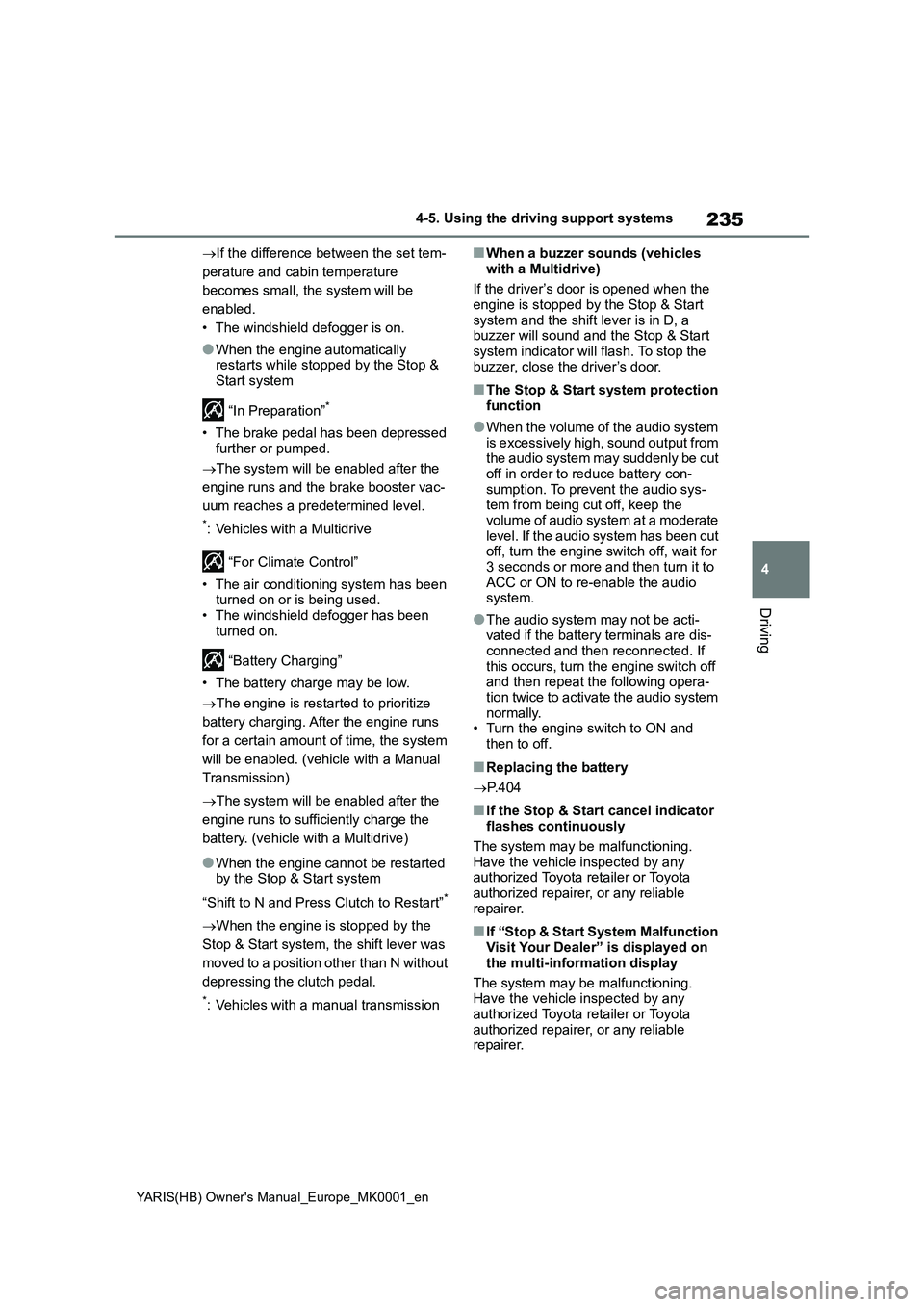
235
4
YARIS(HB) Owner's Manual_Europe_MK0001_en
4-5. Using the driving support systems
Driving
→If the difference between the set tem-
perature and cabin temperature
becomes small, the system will be
enabled.
• The windshield defogger is on.
●When the engine automatically
restarts while stopped by the Stop &
Start system
“In Preparation”
*
• The brake pedal has been depressed
further or pumped.
→The system will be enabled after the
engine runs and the brake booster vac-
uum reaches a predetermined level.
*: Vehicles with a Multidrive
“For Climate Control”
• The air conditioning system has been
turned on or is being used.
• The windshield defogger has been
turned on.
“Battery Charging”
• The battery charge may be low.
→The engine is restarted to prioritize
battery charging. After the engine runs
for a certain amount of time, the system
will be enabled. (vehicle with a Manual
Transmission)
→The system will be enabled after the
engine runs to sufficiently charge the
battery. (vehicle with a Multidrive)
●When the engine cannot be restarted
by the Stop & Start system
“Shift to N and Press Clutch to Restart”
*
→When the engine is stopped by the
Stop & Start system, the shift lever was
moved to a position other than N without
depressing the clutch pedal.
*: Vehicles with a manual transmission
■When a buzzer sounds (vehicles
with a Multidrive)
If the driver’s door is opened when the
engine is stopped by the Stop & Start
system and the shift lever is in D, a
buzzer will sound and the Stop & Start
system indicator will flash. To stop the
buzzer, close the driver’s door.
■The Stop & Start system protection
function
●When the volume of the audio system
is excessively high, sound output from
the audio system may suddenly be cut
off in order to reduce battery con-
sumption. To prevent the audio sys-
tem from being cut off, keep the
volume of audio system at a moderate
level. If the audio system has been cut
off, turn the engine switch off, wait for
3 seconds or more and then turn it to
ACC or ON to re-enable the audio
system.
●The audio system may not be acti-
vated if the battery terminals are dis-
connected and then reconnected. If
this occurs, turn the engine switch off
and then repeat the following opera-
tion twice to activate the audio system
normally.
• Turn the engine switch to ON and
then to off.
■Replacing the battery
→P. 4 0 4
■If the Stop & Start cancel indicator
flashes continuously
The system may be malfunctioning.
Have the vehicle inspected by any
authorized Toyota retailer or Toyota
authorized repairer, or any reliable
repairer.
■If “Stop & Start System Malfunction
Visit Your Dealer” is displayed on
the multi-information display
The system may be malfunctioning.
Have the vehicle inspected by any
authorized Toyota retailer or Toyota
authorized repairer, or any reliable
repairer.
Page 236 of 568
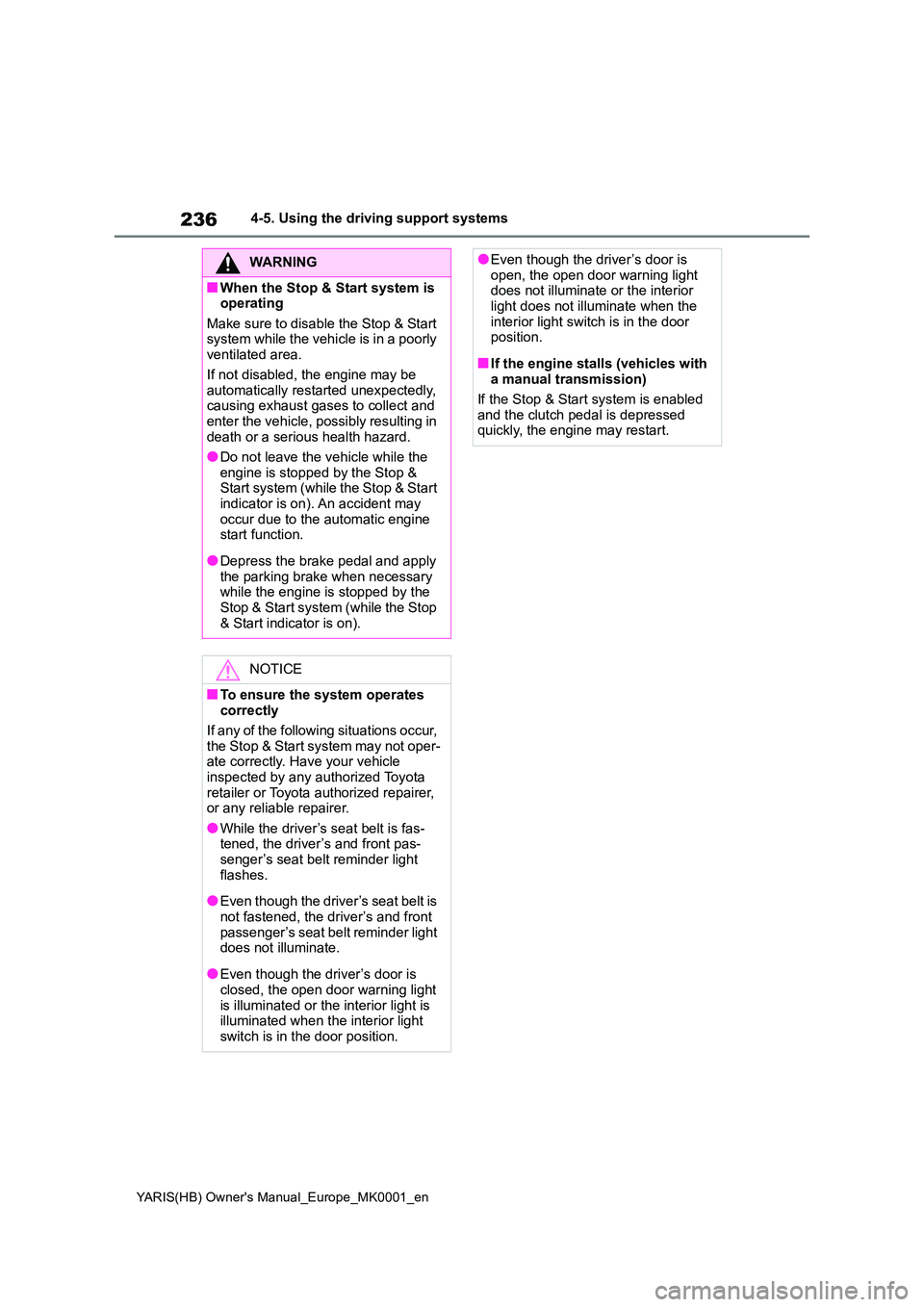
236
YARIS(HB) Owner's Manual_Europe_MK0001_en
4-5. Using the driving support systems
WARNING
■When the Stop & Start system is operating
Make sure to disable the Stop & Start system while the vehicle is in a poorly ventilated area.
If not disabled, the engine may be automatically restarted unexpectedly, causing exhaust gases to collect and
enter the vehicle, possibly resulting in death or a serious health hazard.
●Do not leave the vehicle while the
engine is stopped by the Stop & Start system (while the Stop & Start indicator is on). An accident may
occur due to the automatic engine start function.
●Depress the brake pedal and apply the parking brake when necessary while the engine is stopped by the
Stop & Start system (while the Stop & Start indicator is on).
NOTICE
■To ensure the system operates correctly
If any of the following situations occur, the Stop & Start system may not oper-ate correctly. Have your vehicle
inspected by any authorized Toyota retailer or Toyota authorized repairer, or any reliable repairer.
●While the driver’s seat belt is fas-tened, the driver’s and front pas-senger’s seat belt reminder light
flashes.
●Even though the driver’s seat belt is
not fastened, the driver’s and front passenger’s seat belt reminder light does not illuminate.
●Even though the driver’s door is closed, the open door warning light
is illuminated or the interior light is illuminated when the interior light switch is in the door position.
●Even though the driver’s door is open, the open door warning light does not illuminate or the interior
light does not illuminate when the interior light switch is in the door position.
■If the engine stalls (vehicles with a manual transmission)
If the Stop & Start system is enabled and the clutch pedal is depressed quickly, the engine may restart.
Page 241 of 568
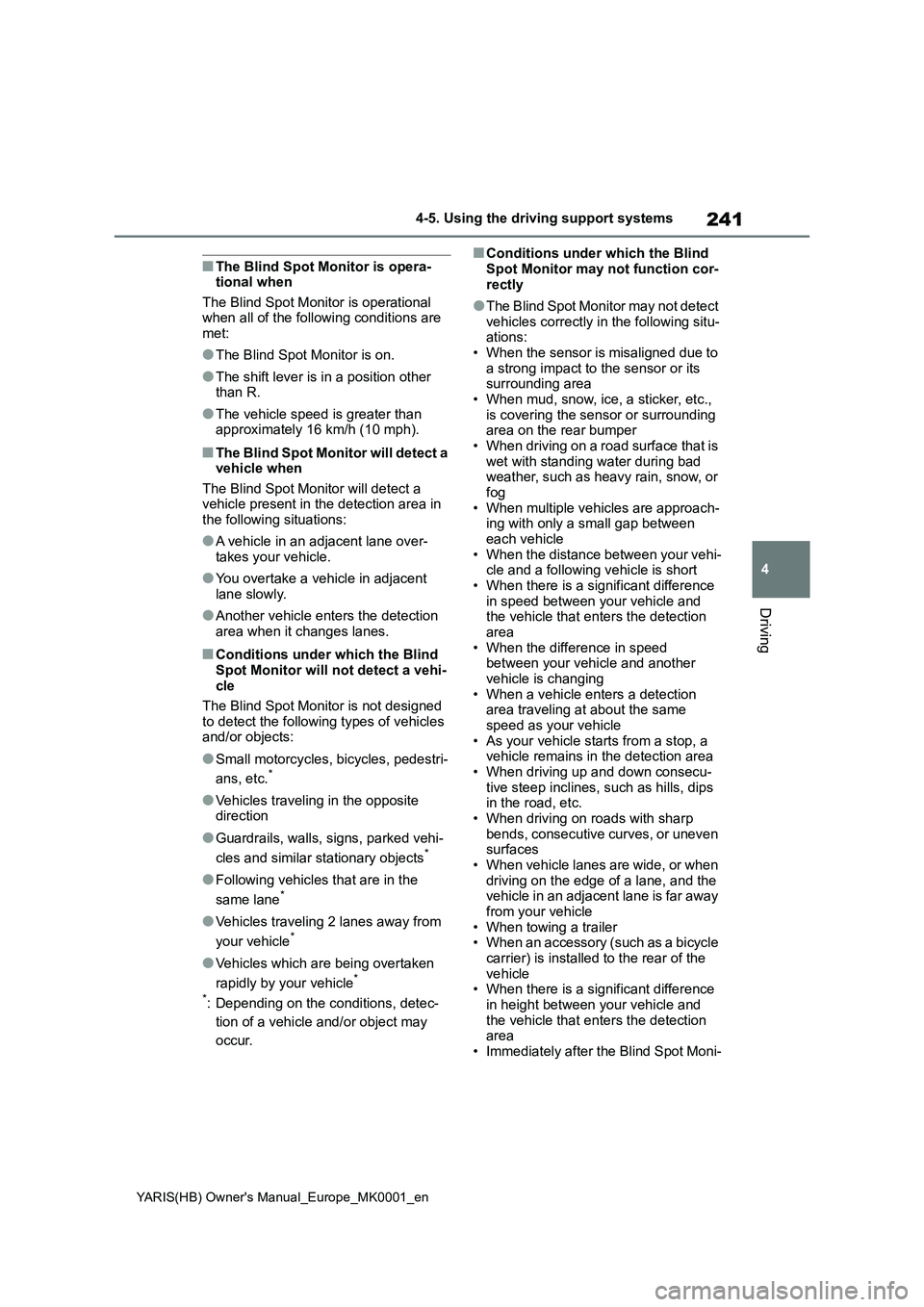
241
4
YARIS(HB) Owner's Manual_Europe_MK0001_en
4-5. Using the driving support systems
Driving
■The Blind Spot Monitor is opera-
tional when
The Blind Spot Monitor is operational
when all of the following conditions are
met:
●The Blind Spot Monitor is on.
●The shift lever is in a position other
than R.
●The vehicle speed is greater than
approximately 16 km/h (10 mph).
■The Blind Spot Monitor will detect a
vehicle when
The Blind Spot Monitor will detect a
vehicle present in the detection area in
the following situations:
●A vehicle in an adjacent lane over-
takes your vehicle.
●You overtake a vehicle in adjacent
lane slowly.
●Another vehicle enters the detection
area when it changes lanes.
■Conditions under which the Blind
Spot Monitor will not detect a vehi-
cle
The Blind Spot Monitor is not designed
to detect the following types of vehicles
and/or objects:
●Small motorcycles, bicycles, pedestri-
ans, etc.*
●Vehicles traveling in the opposite
direction
●Guardrails, walls, signs, parked vehi-
cles and similar stationary objects*
●Following vehicles that are in the
same lane*
●Vehicles traveling 2 lanes away from
your vehicle*
●Vehicles which are being overtaken
rapidly by your vehicle*
*
: Depending on the conditions, detec-
tion of a vehicle and/or object may
occur.
■Conditions under which the Blind
Spot Monitor may not function cor-
rectly
●The Blind Spot Monitor may not detect
vehicles correctly in the following situ-
ations:
• When the sensor is misaligned due to
a strong impact to the sensor or its
surrounding area
• When mud, snow, ice, a sticker, etc.,
is covering the sensor or surrounding
area on the rear bumper
• When driving on a road surface that is
wet with standing water during bad
weather, such as heavy rain, snow, or
fog
• When multiple vehicles are approach-
ing with only a small gap between
each vehicle
• When the distance between your vehi-
cle and a following vehicle is short
• When there is a significant difference
in speed between your vehicle and
the vehicle that enters the detection
area
• When the difference in speed
between your vehicle and another
vehicle is changing
• When a vehicle enters a detection
area traveling at about the same
speed as your vehicle
• As your vehicle starts from a stop, a
vehicle remains in the detection area
• When driving up and down consecu-
tive steep inclines, such as hills, dips
in the road, etc.
• When driving on roads with sharp
bends, consecutive curves, or uneven
surfaces
• When vehicle lanes are wide, or when
driving on the edge of a lane, and the
vehicle in an adjacent lane is far away
from your vehicle
• When towing a trailer
• When an accessory (such as a bicycle
carrier) is installed to the rear of the
vehicle
• When there is a significant difference
in height between your vehicle and
the vehicle that enters the detection
area
• Immediately after the Blind Spot Moni-
Page 259 of 568
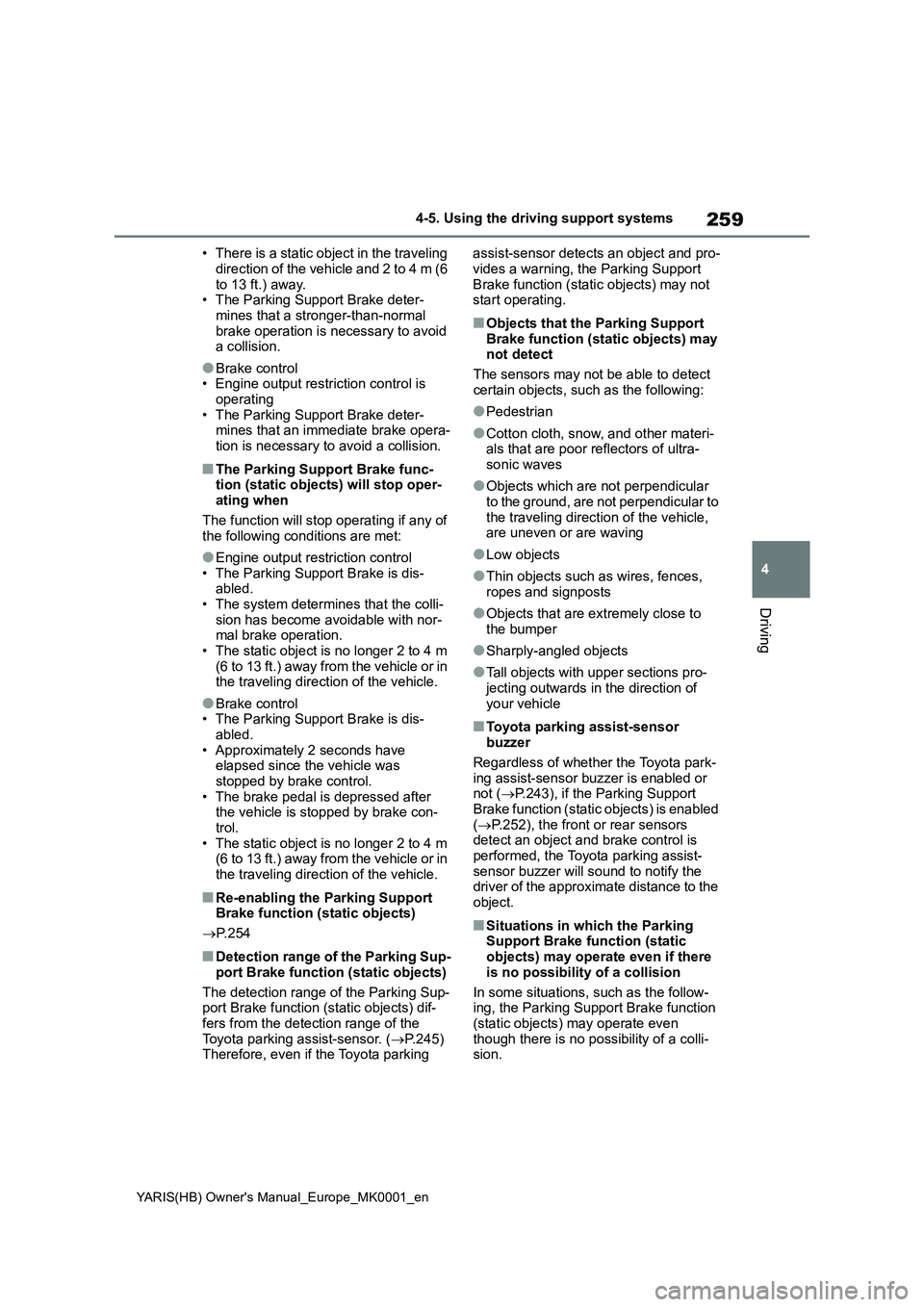
259
4
YARIS(HB) Owner's Manual_Europe_MK0001_en
4-5. Using the driving support systems
Driving
• There is a static object in the traveling
direction of the vehicle and 2 to 4 m (6
to 13 ft.) away.
• The Parking Support Brake deter-
mines that a stronger-than-normal
brake operation is necessary to avoid
a collision.
●Brake control
• Engine output restriction control is
operating
• The Parking Support Brake deter-
mines that an immediate brake opera-
tion is necessary to avoid a collision.
■The Parking Support Brake func-
tion (static objects) will stop oper-
ating when
The function will stop operating if any of
the following conditions are met:
●Engine output restriction control
• The Parking Support Brake is dis-
abled.
• The system determines that the colli-
sion has become avoidable with nor-
mal brake operation.
• The static object is no longer 2 to 4 m
(6 to 13 ft.) away from the vehicle or in
the traveling direction of the vehicle.
●Brake control
• The Parking Support Brake is dis-
abled.
• Approximately 2 seconds have
elapsed since the vehicle was
stopped by brake control.
• The brake pedal is depressed after
the vehicle is stopped by brake con-
trol.
• The static object is no longer 2 to 4 m
(6 to 13 ft.) away from the vehicle or in
the traveling direction of the vehicle.
■Re-enabling the Parking Support
Brake function (static objects)
→P. 2 5 4
■Detection range of the Parking Sup-
port Brake function (static objects)
The detection range of the Parking Sup-
port Brake function (static objects) dif-
fers from the detection range of the
Toyota parking assist-sensor. (→P.245)
Therefore, even if the Toyota parking assist-sensor detects an object and pro-
vides a warning, the Parking Support
Brake function (static objects) may not
start operating.
■Objects that the Parking Support
Brake function (static objects) may
not detect
The sensors may not be able to detect
certain objects, such as the following:
●Pedestrian
●Cotton cloth, snow, and other materi-
als that are poor reflectors of ultra-
sonic waves
●Objects which are not perpendicular
to the ground, are not perpendicular to
the traveling direction of the vehicle,
are uneven or are waving
●Low objects
●Thin objects such as wires, fences,
ropes and signposts
●Objects that are extremely close to
the bumper
●Sharply-angled objects
●Tall objects with upper sections pro-
jecting outwards in the direction of
your vehicle
■Toyota parking assist-sensor
buzzer
Regardless of whether the Toyota park-
ing assist-sensor buzzer is enabled or
not (→P.243), if the Parking Support
Brake function (static objects) is enabled
(→P.252), the front or rear sensors
detect an object and brake control is
performed, the Toyota parking assist-
sensor buzzer will sound to notify the
driver of the approximate distance to the
object.
■Situations in which the Parking
Support Brake function (static
objects) may operate even if there
is no possibility of a collision
In some situations, such as the follow-
ing, the Parking Support Brake function
(static objects) may operate even
though there is no possibility of a colli-
sion.
Page 263 of 568
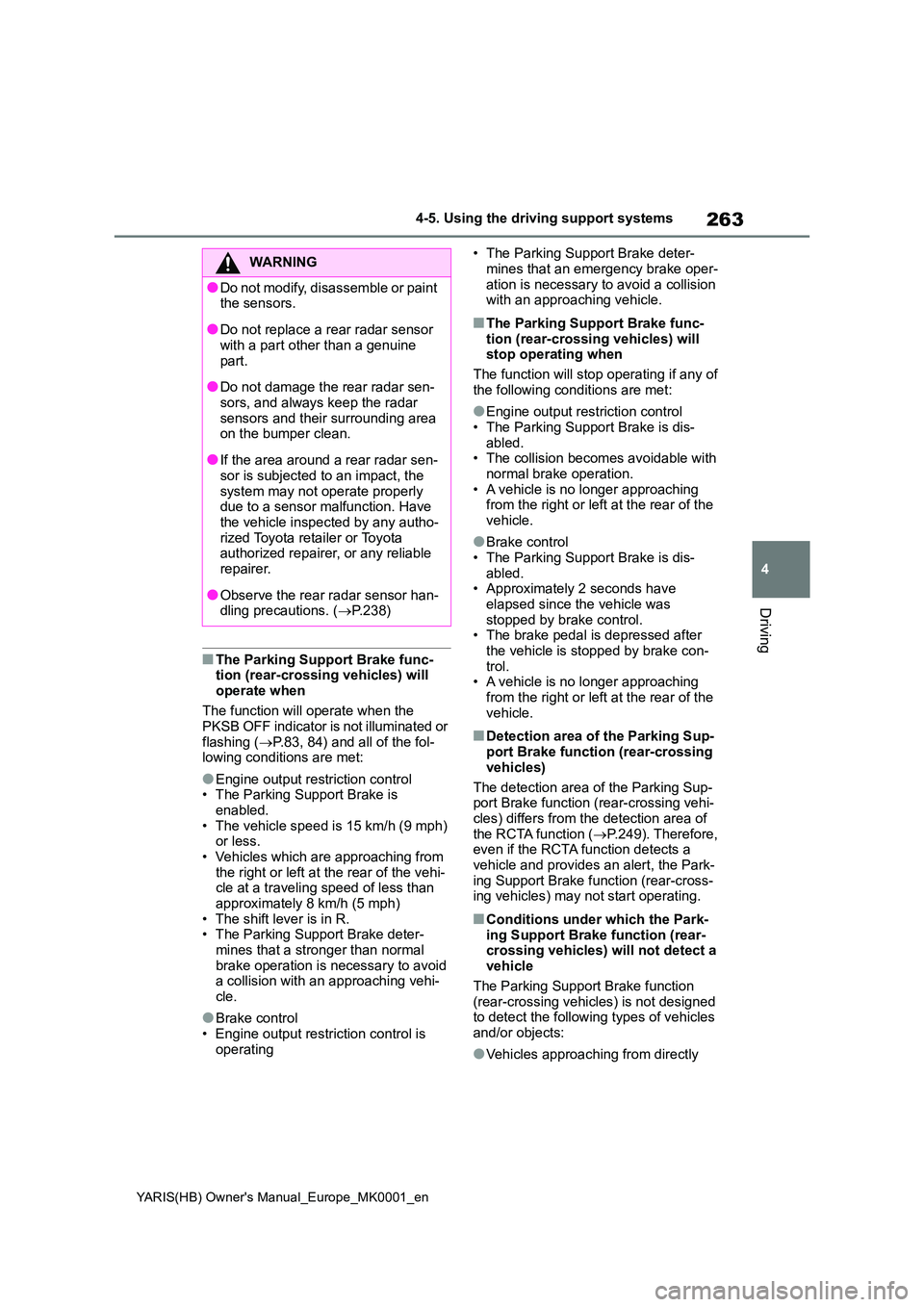
263
4
YARIS(HB) Owner's Manual_Europe_MK0001_en
4-5. Using the driving support systems
Driving
■The Parking Support Brake func- tion (rear-crossing vehicles) will
operate when
The function will operate when the PKSB OFF indicator is not illuminated or
flashing ( →P.83, 84) and all of the fol- lowing conditions are met:
●Engine output restriction control• The Parking Support Brake is enabled.
• The vehicle speed is 15 km/h (9 mph) or less.• Vehicles which are approaching from
the right or left at the rear of the vehi- cle at a traveling speed of less than approximately 8 km/h (5 mph)
• The shift lever is in R. • The Parking Support Brake deter-mines that a stronger than normal
brake operation is necessary to avoid a collision with an approaching vehi-cle.
●Brake control• Engine output restriction control is
operating
• The Parking Support Brake deter-
mines that an emergency brake oper- ation is necessary to avoid a collision with an approaching vehicle.
■The Parking Support Brake func-
tion (rear-crossing vehicles) will stop operating when
The function will stop operating if any of
the following conditions are met:
●Engine output restriction control
• The Parking Support Brake is dis- abled.• The collision becomes avoidable with
normal brake operation. • A vehicle is no longer approaching from the right or left at the rear of the
vehicle.
●Brake control
• The Parking Support Brake is dis- abled.• Approximately 2 seconds have
elapsed since the vehicle was stopped by brake control.• The brake pedal is depressed after
the vehicle is stopped by brake con- trol.• A vehicle is no longer approaching
from the right or left at the rear of the vehicle.
■Detection area of the Parking Sup-port Brake function (rear-crossing
vehicles)
The detection area of the Parking Sup- port Brake function (rear-crossing vehi-
cles) differs from the detection area of the RCTA function ( →P.249). Therefore, even if the RCTA function detects a
vehicle and provides an alert, the Park- ing Support Brake function (rear-cross-ing vehicles) may not start operating.
■Conditions under which the Park-
ing Support Brake function (rear- crossing vehicles) will not detect a vehicle
The Parking Support Brake function (rear-crossing vehicles) is not designed to detect the following types of vehicles
and/or objects:
●Vehicles approaching from directly
WARNING
●Do not modify, disassemble or paint the sensors.
●Do not replace a rear radar sensor with a part other than a genuine
part.
●Do not damage the rear radar sen-
sors, and always keep the radar sensors and their surrounding area on the bumper clean.
●If the area around a rear radar sen-sor is subjected to an impact, the
system may not operate properly due to a sensor malfunction. Have the vehicle inspected by any autho-
rized Toyota retailer or Toyota authorized repairer, or any reliable repairer.
●Observe the rear radar sensor han-dling precautions. ( →P.238)
Page 270 of 568
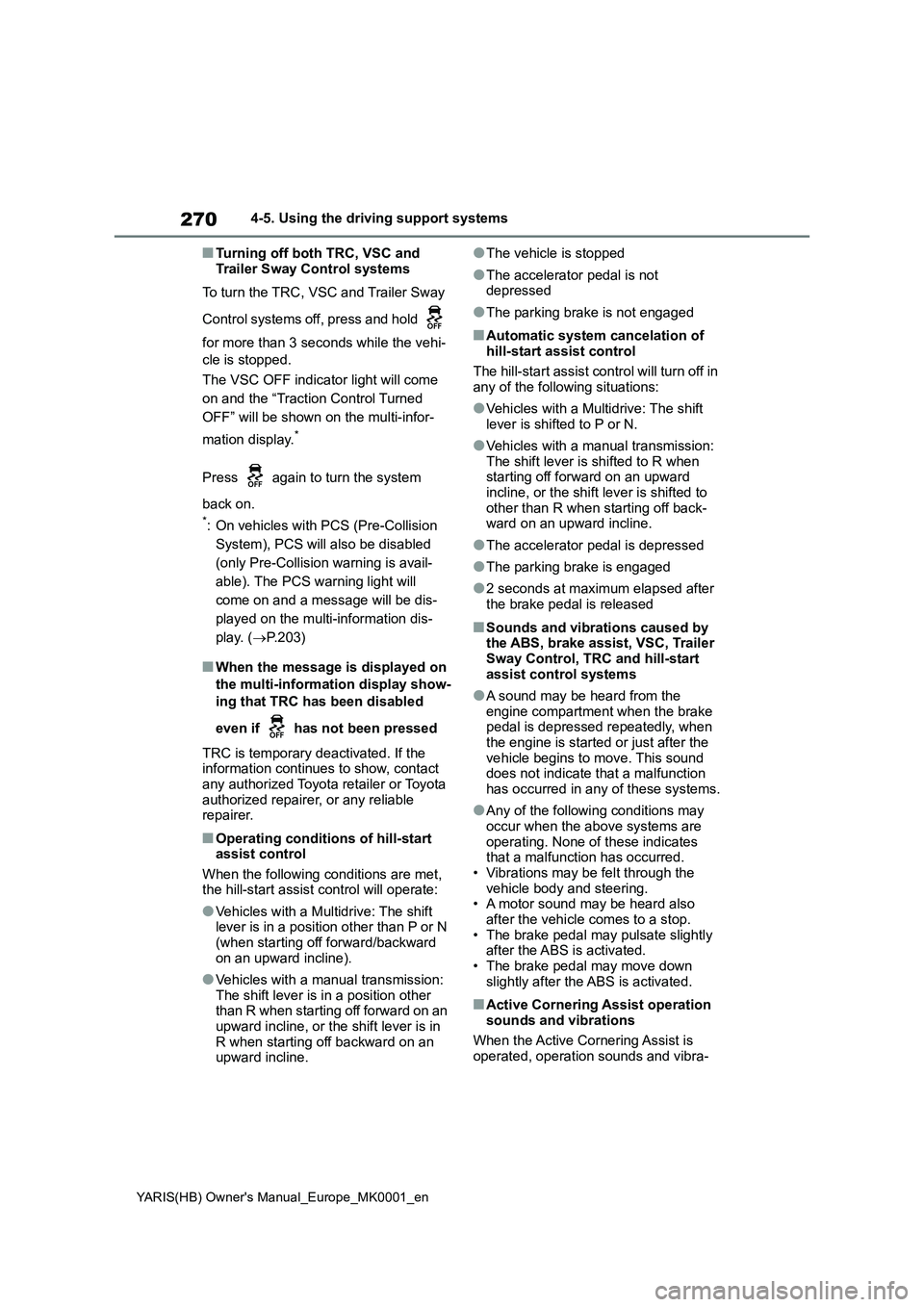
270
YARIS(HB) Owner's Manual_Europe_MK0001_en
4-5. Using the driving support systems
■Turning off both TRC, VSC and
Trailer Sway Control systems
To turn the TRC, VSC and Trailer Sway
Control systems off, press and hold
for more than 3 seconds while the vehi-
cle is stopped.
The VSC OFF indicator light will come
on and the “Traction Control Turned
OFF” will be shown on the multi-infor-
mation display.
*
Press again to turn the system
back on.
*: On vehicles with PCS (Pre-Collision
System), PCS will also be disabled
(only Pre-Collision warning is avail-
able). The PCS warning light will
come on and a message will be dis-
played on the multi-information dis-
play. (→P.203)
■When the message is displayed on
the multi-information display show-
ing that TRC has been disabled
even if has not been pressed
TRC is temporary deactivated. If the
information continues to show, contact
any authorized Toyota retailer or Toyota
authorized repairer, or any reliable
repairer.
■Operating conditions of hill-start
assist control
When the following conditions are met,
the hill-start assist control will operate:
●Vehicles with a Multidrive: The shift
lever is in a position other than P or N
(when starting off forward/backward
on an upward incline).
●Vehicles with a manual transmission:
The shift lever is in a position other
than R when starting off forward on an
upward incline, or the shift lever is in
R when starting off backward on an
upward incline.
●The vehicle is stopped
●The accelerator pedal is not
depressed
●The parking brake is not engaged
■Automatic system cancelation of
hill-start assist control
The hill-start assist control will turn off in
any of the following situations:
●Vehicles with a Multidrive: The shift
lever is shifted to P or N.
●Vehicles with a manual transmission:
The shift lever is shifted to R when
starting off forward on an upward
incline, or the shift lever is shifted to
other than R when starting off back-
ward on an upward incline.
●The accelerator pedal is depressed
●The parking brake is engaged
●2 seconds at maximum elapsed after
the brake pedal is released
■Sounds and vibrations caused by
the ABS, brake assist, VSC, Trailer
Sway Control, TRC and hill-start
assist control systems
●A sound may be heard from the
engine compartment when the brake
pedal is depressed repeatedly, when
the engine is started or just after the
vehicle begins to move. This sound
does not indicate that a malfunction
has occurred in any of these systems.
●Any of the following conditions may
occur when the above systems are
operating. None of these indicates
that a malfunction has occurred.
• Vibrations may be felt through the
vehicle body and steering.
• A motor sound may be heard also
after the vehicle comes to a stop.
• The brake pedal may pulsate slightly
after the ABS is activated.
• The brake pedal may move down
slightly after the ABS is activated.
■Active Cornering Assist operation
sounds and vibrations
When the Active Cornering Assist is
operated, operation sounds and vibra-
Page 272 of 568

272
YARIS(HB) Owner's Manual_Europe_MK0001_en
4-5. Using the driving support systems
WARNING
●The vehicle hydroplanes while driv- ing at high speed on wet or slick
roads.
■Stopping distance when the ABS
is operating may exceed that of normal conditions
The ABS is not designed to shorten
the vehicle’s stopping distance. Always maintain a safe distance from the vehicle in front of you, especially
in the following situations:
●When driving on dirt, gravel or
snow-covered roads
●When driving with tire chains
●When driving over bumps in the road
●When driving over roads with pot-holes or uneven surfaces
■TRC/VSC may not operate effec-tively when
Directional control and power may not be achievable while driving on slip-pery road surfaces, even if the
TRC/VSC system is operating. Drive the vehicle carefully in conditions where stability and power may be
lost.
■Active Cornering Assist does not
operate effectively when
●Do not overly rely on Active Corner- ing Assist. Active Cornering Assist
may not operate effectively when accelerating down slopes or driving on slippery road surfaces.
●When Active Cornering Assist fre-quently operates, Active Cornering
Assist may temporarily stop operat- ing to ensure proper operation of the brakes, TRC and VSC.
■Hill-start assist control does not operate effectively when
●Do not overly rely on hill-start assist
control. Hill-start assist control may not operate effectively on steep inclines and roads covered with ice.
●Unlike the parking brake, hill-start assist control is not intended to hold
the vehicle stationary for an extended period of time. Do not attempt to use hill-start assist con-
trol to hold the vehicle on an incline, as doing so may lead to an acci-dent.
■When the TRC/VSC/Trailer Sway Control is activated
The slip indicator light flashes. Always drive carefully. Reckless driving may cause an accident. Exercise particular
care when the indicator light flashes.
■When the TRC/VSC/Trailer Sway
Control systems are turned off
Be especially careful and drive at a speed appropriate to the road condi-
tions. As these are the systems to help ensure vehicle stability and driv-ing force, do not turn the
TRC/VSC/Trailer Sway Control sys- tems off unless necessary.Trailer Sway Control is part of the
VSC system and will not operate if VSC is turned off or experiences a malfunction.
■Replacing tires
Make sure that all tires are of the
specified size, brand, tread pattern and total load capacity. In addition, make sure that the tires are inflated to
the recommended tire inflation pres- sure level.The ABS, TRC Trailer Sway Control
and VSC systems will not function correctly if different tires are installed on the vehicle.
Contact any authorized Toyota retailer or Toyota authorized repairer, or any reliable repairer for further information
when replacing tires or wheels.
Page 300 of 568
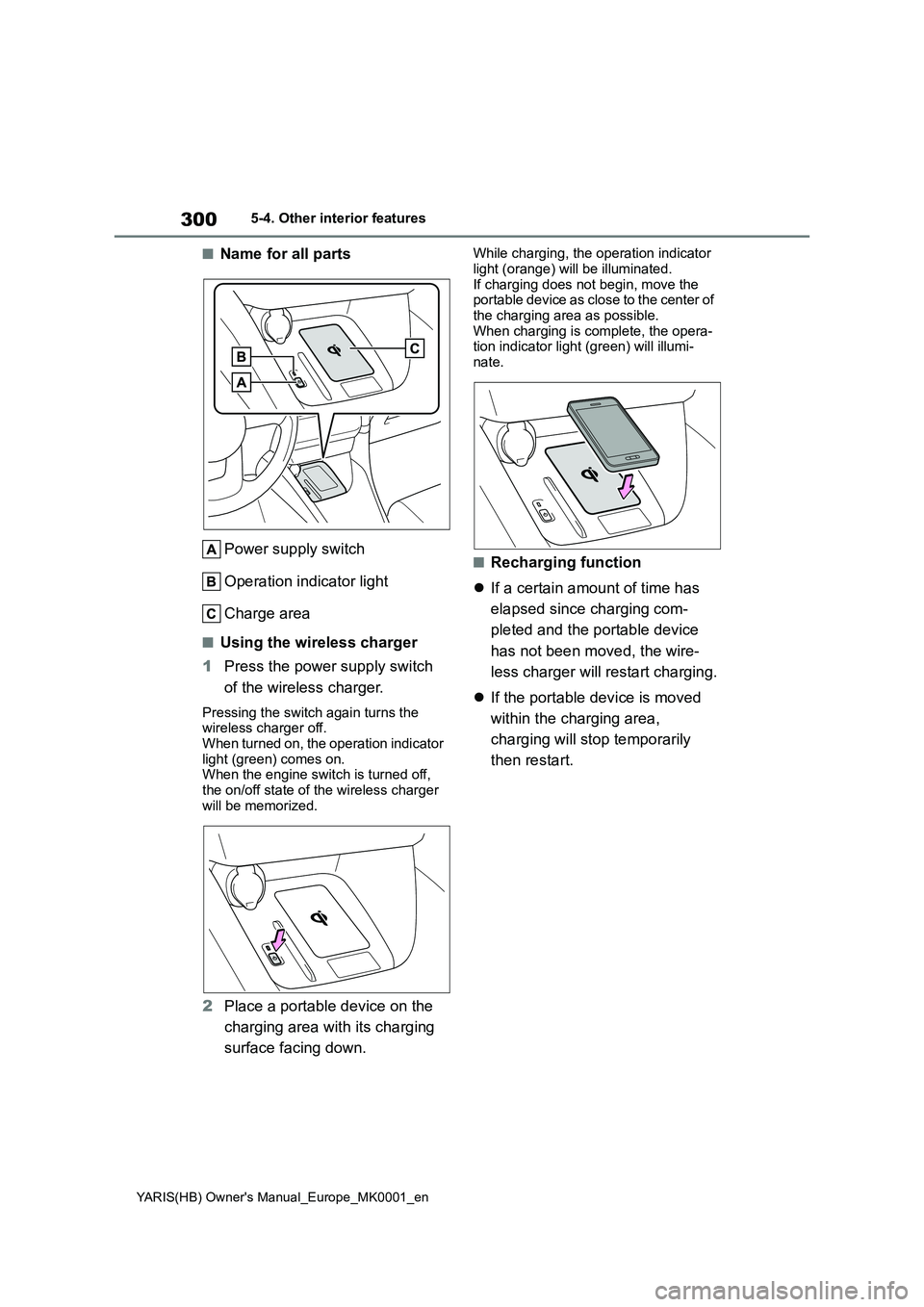
300
YARIS(HB) Owner's Manual_Europe_MK0001_en
5-4. Other interior features
■Name for all parts
Power supply switch
Operation indicator light
Charge area
■Using the wireless charger
1Press the power supply switch
of the wireless charger.
Pressing the switch again turns the
wireless charger off.
When turned on, the operation indicator
light (green) comes on.
When the engine switch is turned off,
the on/off state of the wireless charger
will be memorized.
2Place a portable device on the
charging area with its charging
surface facing down.
While charging, the operation indicator
light (orange) will be illuminated.
If charging does not begin, move the
portable device as close to the center of
the charging area as possible.
When charging is complete, the opera-
tion indicator light (green) will illumi-
nate.
■Recharging function
�zIf a certain amount of time has
elapsed since charging com-
pleted and the portable device
has not been moved, the wire-
less charger will restart charging.
�zIf the portable device is moved
within the charging area,
charging will stop temporarily
then restart.
Page 335 of 568
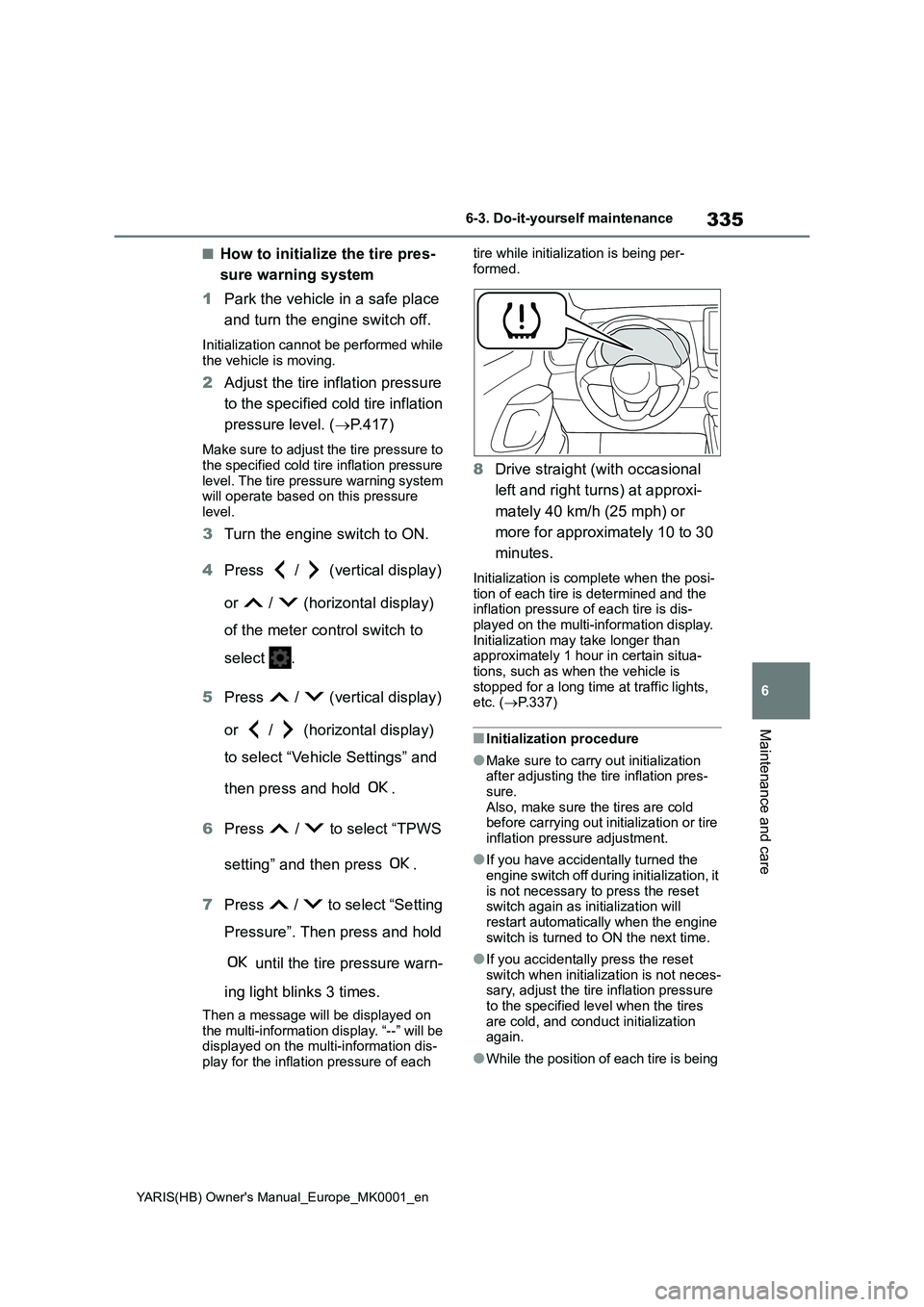
335
6
YARIS(HB) Owner's Manual_Europe_MK0001_en
6-3. Do-it-yourself maintenance
Maintenance and care
■How to initialize the tire pres-
sure warning system
1Park the vehicle in a safe place
and turn the engine switch off.
Initialization cannot be performed while
the vehicle is moving.
2Adjust the tire inflation pressure
to the specified cold tire inflation
pressure level. (→P.417)
Make sure to adjust the tire pressure to
the specified cold tire inflation pressure
level. The tire pressure warning system
will operate based on this pressure
level.
3Turn the engine switch to ON.
4Press / (vertical display)
or / (horizontal display)
of the meter control switch to
select .
5Press / (vertical display)
or / (horizontal display)
to select “Vehicle Settings” and
then press and hold .
6Press / to select “TPWS
setting” and then press .
7Press / to select “Setting
Pressure”. Then press and hold
until the tire pressure warn-
ing light blinks 3 times.
Then a message will be displayed on
the multi-information display. “--” will be
displayed on the multi-information dis-
play for the inflation pressure of each tire while initialization is being per-
formed.
8Drive straight (with occasional
left and right turns) at approxi-
mately 40 km/h (25 mph) or
more for approximately 10 to 30
minutes.
Initialization is complete when the posi-
tion of each tire is determined and the
inflation pressure of each tire is dis-
played on the multi-information display.
Initialization may take longer than
approximately 1 hour in certain situa-
tions, such as when the vehicle is
stopped for a long time at traffic lights,
etc. (→P.337)
■Initialization procedure
●Make sure to carry out initialization
after adjusting the tire inflation pres-
sure.
Also, make sure the tires are cold
before carrying out initialization or tire
inflation pressure adjustment.
●If you have accidentally turned the
engine switch off during initialization, it
is not necessary to press the reset
switch again as initialization will
restart automatically when the engine
switch is turned to ON the next time.
●If you accidentally press the reset
switch when initialization is not neces-
sary, adjust the tire inflation pressure
to the specified level when the tires
are cold, and conduct initialization
again.
●While the position of each tire is being